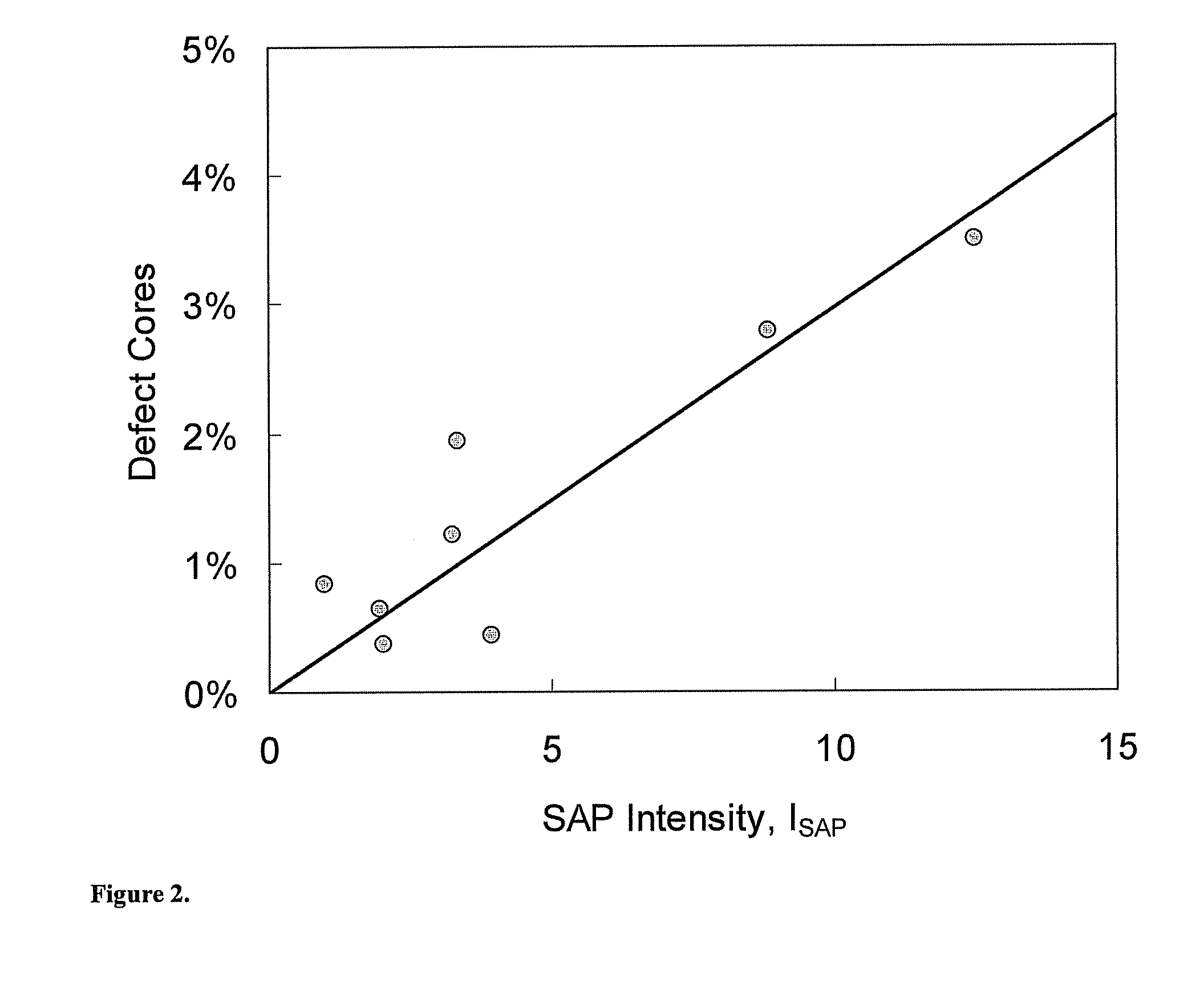Absorbent core comprising multiple sublayers
a technology of absorbent core and sublayer, applied in the field of absorbent core, to achieve the effect of reducing contamination and waste, and reducing the amount of was
- Summary
- Abstract
- Description
- Claims
- Application Information
AI Technical Summary
Benefits of technology
Problems solved by technology
Method used
Image
Examples
example 1
An Evaluation of how the Sap Amount and the Degree of Core Compression Influence the Processability
[0068]The test plan was designed as a full-scale test with three levels of SAP (BASF HySorb M-7055) amounts and three levels of absorption core compressions. The cores were produced in a conventional converting machine at a line speed of 300 m / min and were compressed in-line with a high density compression unit. The measured parameters were resulting core thickness measured at a pressure of 0.5 kPa and amount of defect or missing cores due to clogging to the compression rollers. To count the defect cores, an in-line vision system measuring transmitted light was used. The vision system analyses each core in real time, and cores with a surface area and / or length less than 80% of the specified dimensions were counted as defect cores (300 m / min in this case, and every core was identified).
[0069]By plotting the measured core thickness data versus the core compression nip it is obvious that ...
example 2
An Evaluation of how the Sap Properties Influence the Amount of Defect Cores
[0076]To evaluate how the SAP properties influences the amount of defect cores due to clogging of the compression rollers three different SAP grades were tested. The different SAP grades are presented in Table 1, wherein “7160” refers to a standard SAP, and “7160S” refers to an anti-caking SAP (surface treated). The cores were produced in a standard converting machine at a line speed of 300 m / min and the cores had an upper and a lower layer of pure pulp with a basis weight of approximately 85 g / m2 each and a middle layer of pulp with a basis weight of approximately 85 g / m2 and SAP with a basis weight of approximately 50 g / m2. The amount of defect cores was counted by means of a vision system, cf. Example 1, during production of approximately 30000 cores per experiment. The amount of defect cores per SAP grade is plotted in FIG. 3. From FIG. 3 it is clear that the experiment with cores with pure pulp fibres a...
example 3
SAP Contamination of the Production Machine
[0078]When the produced cores are transported via suction drums there is always a risk of SAP particles spilling out of the cores, resulting in an unwanted contamination of the production machine and unwanted waste of SAP. For the skilled man in the art there is an obvious force balance acting on the SAP particles, cf. FIG. 4 where the positive forces, repulsing the particle, are the gravitational and centrifugal forces, and the negative forces, holding the particle, are the drag force and the pressure gradient force. 4 is valid for the worst case where the gravitational and the centrifugal forces are concurrent. The centrifugal force is dependent of the peripheral velocity of the suction drum and the drag force is dependent of the air velocity through the core, which is related to the core pressure gradient. To evaluate the effect of the different forces the core pressure gradient were varied (by adjusting the rpm of the suction fan). As i...
PUM
| Property | Measurement | Unit |
|---|---|---|
| size | aaaaa | aaaaa |
| pressure | aaaaa | aaaaa |
| density | aaaaa | aaaaa |
Abstract
Description
Claims
Application Information
 Login to View More
Login to View More - R&D Engineer
- R&D Manager
- IP Professional
- Industry Leading Data Capabilities
- Powerful AI technology
- Patent DNA Extraction
Browse by: Latest US Patents, China's latest patents, Technical Efficacy Thesaurus, Application Domain, Technology Topic, Popular Technical Reports.
© 2024 PatSnap. All rights reserved.Legal|Privacy policy|Modern Slavery Act Transparency Statement|Sitemap|About US| Contact US: help@patsnap.com










